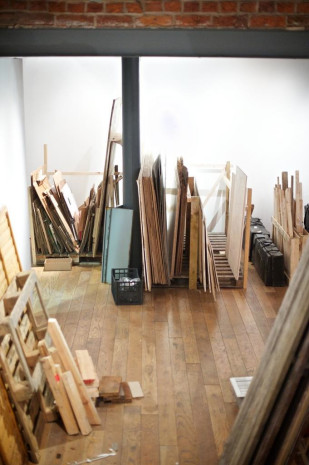
osa/MERZEN @ CUBE, Manchester 18.02.2011 – 16.04.2011
Kurt Schwitters, the master of ‘Merz’ – a self coined phrase he coined that translates as creating collages and assemblages by rearranging collected objects and fragments (the term is said to have been lifted by Schwitters from the title Commerz Bank) – is an artist who holds an almost mythical presence almost sixty years after his death in Kendal, England. To celebrate the impact Schwitters has had on a generation of artists and to highlight his relationship with northern England, Manchester is currently hosting a city wide festival MERZMAN to celebrate the creative legacy of Schwitters. As part of this programme, CUBE Manchester is hosting osa/MERZEN a site specific project undertaken by osa (Office for Subversive Architecture).
As opposed to manifesting itself as an archetypal gallery show, the project takes the form of what could be called ‘an infrequent installation’ where architects from osa employ the spirit of ‘Merz’ to blur the boundaries between the internal architecture of CUBE and new constructs by employing everyday detritus to create physical collages. These materials that range from humble wooden planks, to exhausted Manchester City Council bins have been sourced from the Manchester locale. Visitors are invited to bring in further materials under these conditions to add to the store room. The store room awakens from its static state over three weekends during the duration of the show when the architects raid and plunder it to add to their existing constructs. I visited the show between the second and third open weekend and found that an environment had indeed been forged out of the abundance of materials and waste, with was still more than enough material to build a small fort.

The osa drew inspiration from Schwitters’ collage YMCA Flag, Thank You, Ambleside 1947 (pictured) for the exhibition brief and it the work is quietly sits in a contemplative position between the main galleries and the makeshift material store. The collage acts as a visual map to the mindset of osa and what they aim to achieve in creating temporal architectural modifications. The emphasis on material transformation is one of the key highlighted aspects of the brief and this is evident by the contrast between the lifeless store room and the layered additions of the physical space. The architectural modifications consisting of newspaper, wood, doors, plastic and safety tape flow excellently. The nooks and crannies of CUBE are all sought out and new relationships between existing architectural features do invoke sentiments of Merz whilst displaying a cerebral rationale behind each decision.

CUBE gallery space
The lack of descriptive manual or what basically amounts to antithesis of architectural practice and the template of Merz philosophy ‘sensing without knowing’ allows osa to bask in the freedom of creating a temporary spatial environment out of what is essentially junk. As a part of a Kurt Schwitters celebration, this is a more effective and challenging project than say the production of an environment directly inspired by his Merzbau in 1933. Despite the engaging spatial design, I cannot help but find the majority of exhibitions or projects that presents any part of the gallery environment as a inanimate storage space to be a problematic exhibition model. Even after leaving, I couldn’t help but feel cheated by the fact that these objects lie in a state of limbo with this status unavoidably draped over them like an excessively large paint covered rag.
Whilst acknowledging the nature of the brief and the invitation extended to viewers to bring materials with them to become part of the construction, I couldn’t escape the feeling that osa/MERZEN comes across as a closed project that struggles to resonate beyond it’s own context. Saying this however, I very much enjoyed this intelligent response to a built environment and the attempt of the exhibition to create visual and physical layers whilst addressing contemporary architectural concerns. Perhaps I should take this dose in the spirit of Schwitters and Merz, that this is the point, a singular project that attempts to make sense of our environment by challenging it freely and directly by creating a architectural collage. The final weekend of construction is next Saturday and Sunday. Make it down if you can.